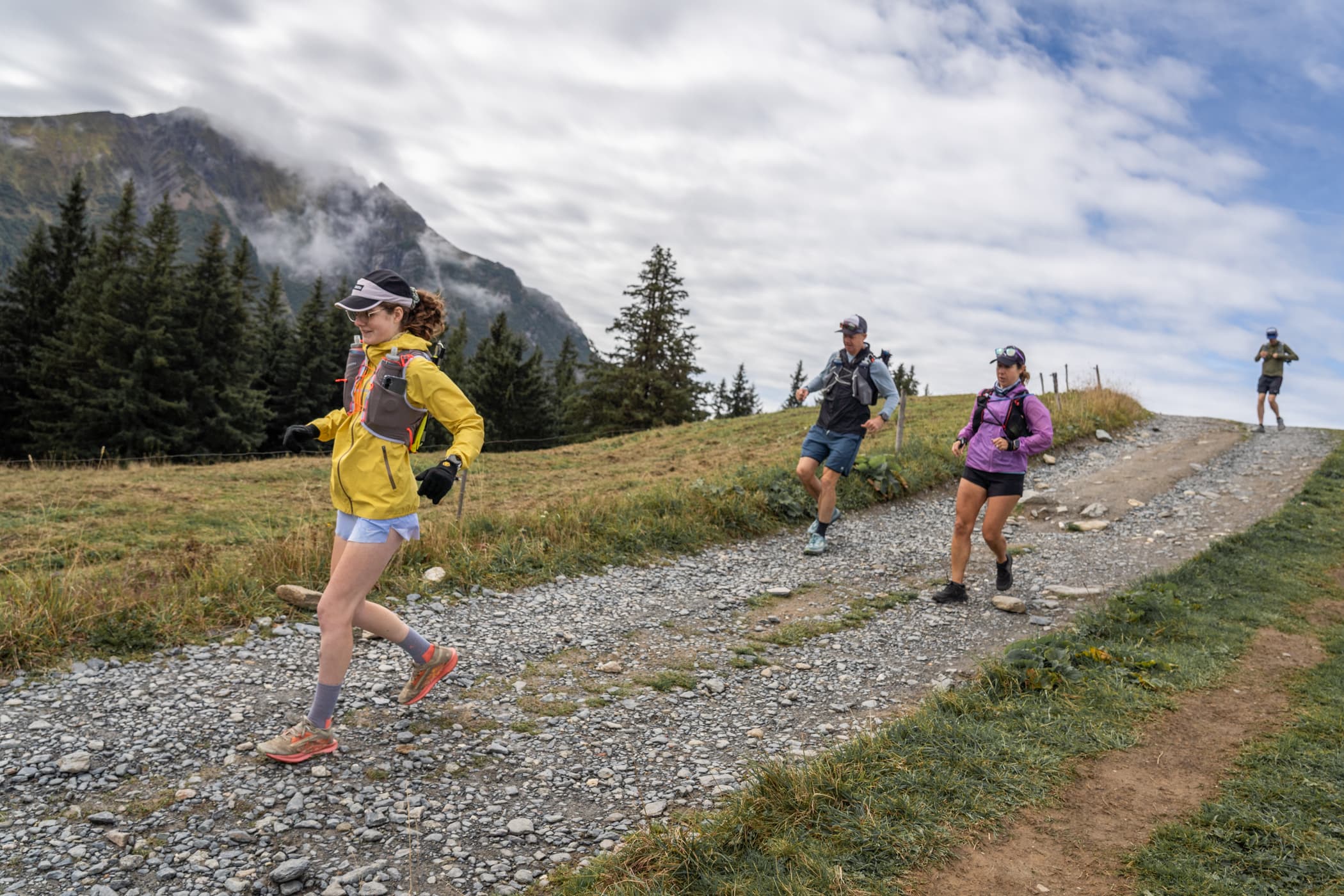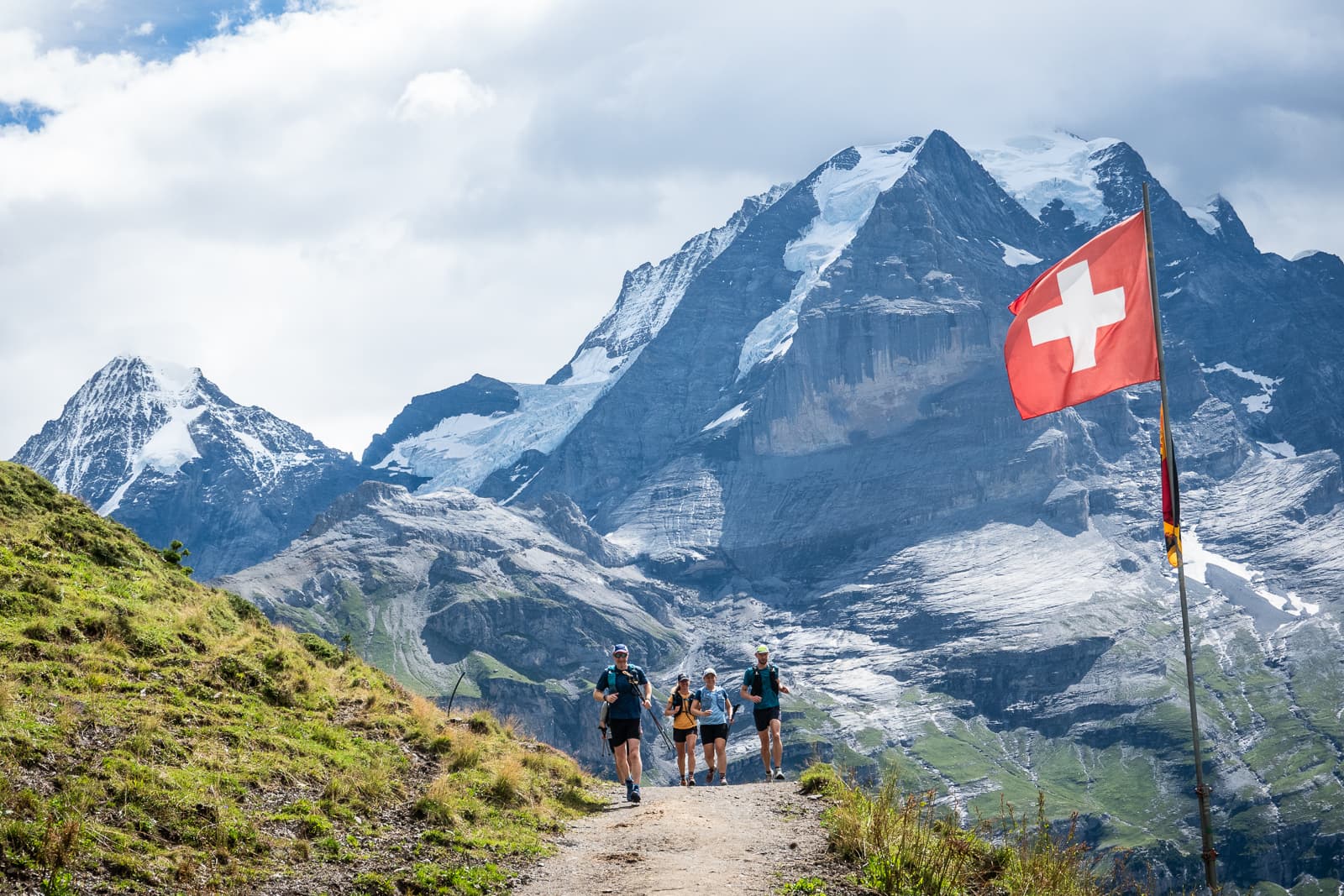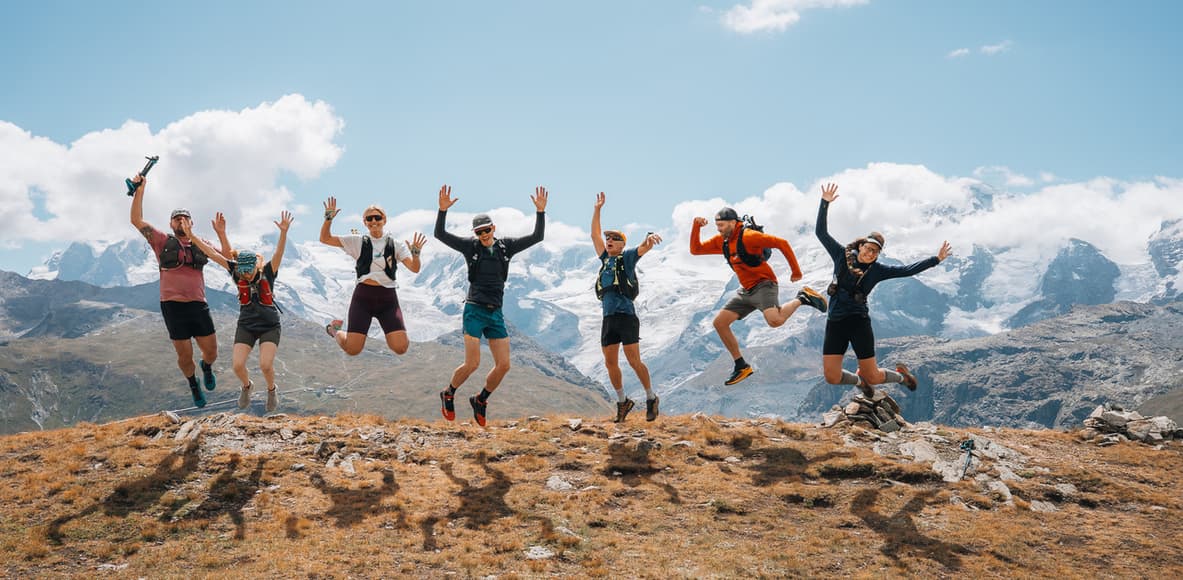
FAQ
Tour Questions
Which is right for me Guided or Self Guided?
If you’d rather avoid planning, navigating and being self-sufficient in the mountains whatever the weather, a guided trip would be best. You’ll have one or two trail running guides who’ll share their knowledge about local languages and customs, as well as being expert trail runners. As qualified mountain leaders, they’ll ensure your safety and also point out wildlife, mountain peaks and historic sights. There are some options to go at your own pace by running ahead to a certain point or taking a variant, but normally the group moves together.
If you prefer to travel solo or with your own companions, always at your own pace, a self-guided tour would suit you. You should be reasonably confident in following trail descriptions and handling the challenges of trail running in a mountainous environment. Dates are flexible, based on your needs, and you can run in one region, or several – it’s your decision. Check out this blog post for more info.
How hard are the runs you do?
That’s largely up to you! We offer tours with different levels of difficulty, as explained in our Grading System. Usually there’s no rush, and you can fast-hike many of the routes, or test your mettle against the verticality of the Alps, and arrive early for lunch at the next hut. But remember that the Alps are steep, and the trails are often technical, so you’ll normally be covering fewer miles in a day than you are used to. You can see how we grade our tours here.
Your trips look great, but I’m worried about being too slow!
Don’t worry– it’s the most common concern we get! Here’s the good news.
Run the Alps offers a range of trips, so you can find one that suits your needs. If you’re not sure how to pick, drop us a note and we can help make sure you’re signing up for a trip that’s right for you.
On our guided trips, everyone goes at their own pace, and we stress inclusiveness and taking our time to enjoy the day. You will never get left behind.
Read our blog Every Trail Runner’s Biggest Fear: Keeping Up With the Group to learn more.
How do I train for running in the Alps?
If you think you might benefit from a little extra help, we’ve got plenty of resources for you. In our Training for Trail Running in the Alps section, we recommend a few coaches and apps, plus share our own training blogs and videos.
The simplest way to train is to crank up the angle on the treadmill at your gym, or start going up some hills. Need distraction? Study a few simple phrases of French or German.
What are reasonable prerequisites so I feel comfortable on a trip?
Good question! It depends on the difficulty of the tour you choose, but in general, you’ll get the most enjoyment out of a trail running vacation in the Alps if you are a regular runner, and don’t mind an hour of steep uphill hiking or running. If you’re planning to run a trail race, it’s helpful to have run at least one comparable trail race elsewhere. Prior mountain experience, such as hiking trips, backcountry skiing, or climbing are certainly helpful, too! There’s more info on how we grade our tours here.
Do I need travel insurance for my Run the Alps trip?
Yes—Run the Alps requires travel insurance. When you register for your Run the Alps trip, you have the option to waive our trip insurance requirement. If you choose this option, you acknowledge that you read and understand Run the Alps’ terms and conditions and that exceptions are never granted to our refund schedule.
Each year, we have some guests who have to cancel for various life reasons: injury, work changes, or other personal life events.
Because of fixed costs, we cannot grant waivers to be more generous than the sliding scale offered in our terms and conditions. Travel insurance will help you in the event that you have to cancel your trip for reasons outside your control.
You can use any company you like for your trip insurance. To help get you started, we’ve researched a lot of travel-insurance programs. And we’ve partnered with the most reputable company we can find: IMG, the International Medical Group. IMG offers several levels of travel insurance, from basic to comprehensive. IMG’s services also come with additional offerings such as lost-luggage reimbursement, lost-passport assistance, emergency cash transfers, and more.
We’ve answered some common questions about travel insurance here.
My partner likes to hike or mountain bike. Can they come along?
In short…. often, yes. We sometimes have one or two partners on a trip who prefer to hike or bike instead of trail run. Our guide(s) will do everything possible to accommodate them. In general, many of our day trips can be accomplished as a hike, sometimes with the addition of a bus, train or tram ride. During the day, it’s often possible for the partner to meet the trail running crew at a hut or inn. Some trips are better suited than others for a combination of hiking or biking and trail running. Going self-guided is optimum, as this allows you and your partner maximum flexibility. To discuss options, please drop us a note.
Cost & Money
Do you offer discounts for returning guests?
Yes, we love welcoming our alumni back to the Alps and offer a 10% discount on all standard Run the Alps trips. Simply check the alumnus box on the registration form and we’ll apply the discount when we invoice you. Please note, this discount is for alums only, it cannot be shared with non-alums and does not apply to trips with guest runners.
Do you offer group discounts?
We do! When we create tours for a group of five or more self-guided guests, there is an opportunity for some savings and we’re pleased to pass them on to you. If you’d like to explore your options, please get in touch.
Why are your tours more expensive than some other companies?
We constantly develop and produce some of the best support materials in the business, such as our 60 page Guide to Trail Running in the Alps – every guest receives this, and Run the Alps Aid Station documents, to help get your trip off to a great start. We hire the best trail running guides available and invest in their training. We use top local suppliers, staying in a select number of carefully-vetted high quality hotels, avoiding dormitory spaces. From our year-‘round base in Chamonix, we can provide you with 24/7 support. Please compare tour offerings carefully!
What’s a single supplement?
Run the Alps trip pricing is based on a double-occupancy room. However, if you’re a single traveler and prefer your own space, the single supplement fee covers the cost of upgrading to private rooms where possible. On some trips—notably our Tour du Mont-Blanc trail run—it’s not always possible to secure a private room at the smaller mountain inns. In the Alps, innkeepers will generally not allow an individual to pay for a double room and use it as a single, preferring to fill their inn and make the best use of the limited space. On our Tour du Mont Blanc run, therefore, the single supplement only guarantees a private room in Chamonix at the start and finish, and in Courmayeur, Italy. Where possible, we will work to secure one of the few single rooms at the remote mountain inns. If you are traveling alone and would like to share a room with another trail runner, we will do everything we can to match you up with another traveller in either a single-gender or mixed-gender room, according to your preference. If that is not possible, however, the single supplement will apply.
I really want to go on a trip, but I don’t think I can afford it. Is there any way to get financial support?
Run the Alps is committed to making our trips more inclusive and is offering grants to help people from historically underrepresented and excluded communities – including, but not limited to, people of color, LGBTQIA+ individuals, adaptive athletes and those facing socio economic barriers – join our trips. You can learn more and apply here.
How much should I tip when I am in the Alps?
Tipping is less important in Europe than it is in much of the rest of the world. In general, you could tip around 5-10% of your bill, or simply round up. For example, paying 40 euros for a meal that cost 36 euros is entirely reasonable.
What about tipping my Run the Alps guide?
If your Run the Alps guide did a great job, please consider a tip for him or her, too! About 5% of your tour cost per guide is a reasonable rule of thumb, but any tip or gift will be greatly appreciated.
On the Trail
Do some runners walk or fast hike sections?
Absolutely! Here’s a serious point: Pretty much everyone walks up the hills in the Alps – including the Pros! Also, we’re not competitive. Trail running for us is about personal accomplishment, the pleasure of being in the mountains with friends, the joy of working hard in a beautiful setting… and enjoying a few luxuries after the run. If you’re into running as fast as you can, go for it—we’ll see you at the hut!
Are there easier options along the way?
We try to include a variety of options on each day’s runs. That’s not always possible, but it’s often the case that there’s a lift, funicular, tram or cog railway available for part of the route or waiting to take you back to wine, a croissant, and a massage if needed!
Can I take a day off?
If you insist, but we’ll want a full report on the tarts, cheese and cappuccino you found in town! This is usually possible on our tours, but the point-to-point itineraries of our Tour du Mont-Blanc and Via Valais trips make it hard to take a day off, so consider another trip option if you think that is likely to be necessary.
What’s the weather like?
The Alps are classic “big mountains,” so the answer has to be; expect anything. We’ve seen snow in August, sunny days in November, and driving rain for a few days at a time. On average, however, it’s typical to have a few days of unsettled weather over the course of a ten-day period. September usually has better weather than August, which usually has better weather than July. Up high in the mountains, poor conditions can move in quickly, so it’s imperative to pay close attention to the forecast, watch the sky over the course of the day, and be flexible with your plans if conditions dictate.
What about the altitude?
This is one of the most common questions we get, and it’s an interesting one! Here’s why. In the Alps, glaciers and technical climbing starts around 3,000 meters, or 9,800 feet, roughly speaking. The highest pass we cross on the Tour du Mont Blanc, for example, is 2,537 meters, or about 8,300 feet– just high enough to begin to notice the altitude. But before you know it, you’re down in the village of La Fouly, at 1,600 meters, or about 5,250 feet. So, in general, altitude and acclimatization is not an issue.
What’s the footing like?
It can vary, from rocky footing to decadent pastures. In general, the terrain is usually quite running-friendly, with switch-backed routes and plenty of soil. The higher we go, however, the more challenging and rocky the trails get. Over 2,500 meters, or about 8,200 feet, it’s not uncommon to encounter scree or boulder fields. Check out our Grading System to learn more about footing on each particular tour.
What about the exposure?
Alps running will have moments of exposure to steep cliffs and airy gaps. These locations are often equipped with chains or cables that are bolted to the rock. At spots like this, we stop running, and always make sure to have one hand on the cable. If you’re subject to vertigo, there are often other running options or, as we’ve been known to do from time to time, simply watch the feet of the person in front of you and focus your mind on a fine alp cheese! We consider exposure as part of the tour level in our grading system – ie. a level 1 tour has less exposure than a level 4 tour.
What’s in your trail running pack?
We’re in the mountains, and that means being able to take care of ourselves in the event of an accident or foul weather. Guides will have additional resources, such as satellite phones and first aid kits. Our Guide to Trail Running in the Alps, sent upon signing up for a trip, has full details on what to bring. You’ll know what works best for you, but, in general, we’d suggest the following:
Personal snacks for the day to supplement those provided by the Guide
Dry shirt, warm hat, liner gloves
Rain shell
Dry socks
Sunscreen, Vaseline or other anti-chafe lubricant
Extra francs, passport, credit card, ATM card, Swiss card
Map of the area, route and map description for the day, if self-guided
Baseball cap
Sunglasses
Cell phone
Soft flasks/bladder with at least 1.5 liters capacity
Do I need any special equipment?
Many runners, particularly locals, like to trail run with carbon fiber running poles. This is a matter of personal preference. In the Alps, we find it handy as a third point of contact with the ground can be comforting on very steep terrain, the poles move some of the hard work to your upper body on climbs, and they remove a small but noticeable percentage of the pounding on long down hills. We recommend the Black Diamond Distance Carbon Z trekking poles, ordered in the length that is right for you. (The adjustable poles add not-insignificant weight.) On our guided trips, Run the Alps will bring a variety of poles for you to try out, and in Grindelwald, Zermatt, Courmayeur and Chamonix, it’s possible to buy them.
Food
Can specific dietary restrictions and preferences be accommodated on a tour?
Yes, we can accommodate nearly all dietary needs, including allergies, intolerances, and personal preferences, but it’s important you let us know before your trip starts. Your preferences will be communicated to the hotels and huts along your route, and cannot be changed during your trip. At restaurants without set menus, you’ll be able to select what you like.
In the past, the Alps eateries were known for being a bit unfriendly about food preferences, but these days, it’s becoming more common to adapt to different dietary needs. Still, options are likely to be limited compared to what you might expect at home.
You may wish to supplement in areas you are specifically concerned about; for example, if you are vegetarian or vegan, you may want to bring additional sources of protein.
You can read more about eating in the Alps for a specific diet on our blog: Eat Your Way Around the Alps: Vegan, Vegetarian, and Gluten-Free.
What about lunches on days we’re trail running?
Generally, we don’t stop for heavy lunches during a trail running day. Our guides will purchase a variety of snacks to share out at the start of the day. We’ll do our best to match the desires of the group with what’s available locally, but many brands familiar to trail runners in other countries are not available in the Alps. We’ll have chocolate, nuts, chips, energy bars, and other foods along for us to choose from each day. If you have a specific brand that works well for you, we’d suggest you bring enough with you for the duration of the trip. We’ll also stop at huts and mountain inns, en route, if you find yourself in need of something more substantial, or would like a treat during the trail run.
Let it Ripple: Run the Alps x Alpine Run Project

This past season, Run the Alps and Alpine Run Project, launched an internship program that included shadowing a guide on a Run the Alps tour.
Bernese Oberland Trail Running

Our trail running tours of Switzerland’s Bernese Oberland will traverse some of the most famous mountain terrain anywhere in the Alps, if not the world.
Join the Club: Run the Alps on Strava!

Run the Alps has just launched a Strava Club. We’ll see you on the trails for our first Challenge – kudos and goodies are waiting!